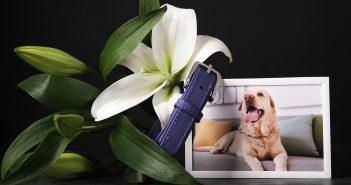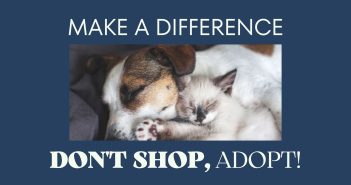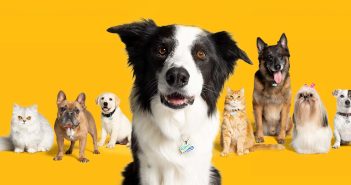If you have just picked up a camera for the first time, or have been taking pictures for years, the information contained in this guide will ensure that you do not overlook anything as you frame and shoot that picture. At pet shows, and especially dog shows, enthusiasts like yourself pay close attention to every detail down to making sure that every hair is in place, the bows in the top knot are perfect, down to the shine on the glistening coats. The end quality of your picture is dependent upon your attention to details. Whenever we take a photograph for a client and create their unique art we do exactly the same. Starting with the right photograph is key and we will provide some often overlooked aspects of pet photography. Remember that you must start with the right photograph in order to obtain good and even great results.
There are two assumptions made here. The first is that you are interested in color photography and the second is that you have read your camera owner’s manual and understand the features and capabilities – at least at a basic level. With that said, the intent of this guide is to help you get started with taking photographs and getting the best possible results. Before we continue, there is one thing often overlooked until it is too late that will ruin a great photograph. Shut off the date and time stamp feature. You can be sure that it will always take away from the picture or be in the wrong place where no amount of editing can account for it.
Picture Quality
The focus here is to start with the best of everything possible and use your camera to the fullest. This does not mean that you need to spend $2000 on a camera and special lenses, but it does mean taking advantage of the best capabilities your camera provides. Even a $100 camera can create good small prints. After you understand your cameras feature menu and how to navigate it, go back and re-read the picture quality section again. Once you understand that section set your camera to the BEST modes possible.
Many cameras have resolution settings similar to Normal, Better, Fine, and quality settings of Good, Better, Best. Select the Fine and Best modes or what ever your camera calls the highest quality and highest resolution modes. You can always reduce the resolution and quality later if needed, but you can never improve it. Starting off with the best quality photograph gives you the best possible chance of having a great photograph and piece of art. This becomes even more important when making larger prints or even posters. As you increase picture quality, your memory card will fill quicker and be able to store fewer images. Be sure that you have a large enough memory card or multiple cards. Remember, you do not want to run out of storage when your pet is doing something that will look great on that next Christmas card, so be sure to have that extra 512M or 1G card handy
Lens Filters and Shades
If you must take photographs in bright sun, such as at an outside farm and pet show, use a lens shade and force flash to overcome the harsh sun. One alternative to use especially if your flash is not powerful enough, is a polarizing filter instead of the flash. The polarizing filter is one of the most useful filters for outdoor photography and is a requirement for any serious photographer, especially for those that use a digital camera. A polarizing filter will reduce the glare and make colors stand out more in harsh sun conditions. These filters can significantly reduce white-outs or wash-outs (surfaces with the primary color all washed out) due to bright reflections. An example of this would be your golden lab having a whitish back, and dark murky looking legs lacking in detail. Some photograph flaws can be edited out and touched up, however, these flaws are nearly impossible to eliminate after the fact and make the editing look natural.
A second important tool to have in your camera bag is a lens shade. A lens shade is inexpensive and is attached on the end of your lens to keep excess light from directly entering the lens. It basically provides a tunnel that shields the optics (lens), and due to its black color absorbs any bouncing light. This helps the camera to better detect the light levels of the subject.
Express your Pets Personality Through Creative Art
People find many ways to express their personality, whether it is through sports, music, art, or another outlet. In any case, the creative nature that we have comes to the surface once we have the tools and have developed ability to accomplish this. One area that has continued to grow as a result of technological advancement is with computer enhanced graphics. Faster home computers coupled with programs such as Adobe Photoshop and Illustrator have taken the high end graphics work once limited to corporations to smaller businesses. The most basic photo manipulation is to correct flaws in the picture, which can be expanded to the more advanced creation of fantasy scenes, such as overlaying multiple images and the addition of special effects.
The Photo Shoot – The Tricks of Understanding Your Pet
Now that you have a general understanding of how to use your camera, lets focus on where, when, and how to get the optimum environment. There are some things in our control, and others that are not, and at any one time they can change. It is important that we discuss each element so you can decide what to do given your situation. These elements are lighting, the location, and the position of the pet. If you are restricted to a specific time of day outside, then you many not have any control over the lighting, or do you? If you are photographing the pet at a show such as walking around the judging stage, you are probably limited to the camera position and location. Ideally you want the best lighting, optimum flexibility with positioning the camera. Lastly if you are going to remove the background from the final print, the cleanest background for editing is desirable. This section will help you take advantage of any flexibility and optimize your shoot given the environment
Pick The Right Lighting
Given that we are focusing on color photography, proper lighting is essential. In fact proper lighting actually means LOTS OF LIGHT, and the correct type of light. Without proper lighting it is nearly impossible to have an award-winning photograph, even one that has been touched up with the best photo editing tools. When it comes to lighting you want to have an even distribution of light over the entire surface of the pet, including the underside areas. This light illuminates all areas, is not harsh or glaring and does not cause shadowing. Light that is at a low-angle such as parallel to 30 degrees above the ground, or when outside, sun rise or sun set is often the best. This low-angle light covers the side surfaces of the pets’ body with light. Light that is high in the air, such as overhead lights, or when outside sun light that is high in the sky such as that mid-day harsh sun should be avoided. This harsh light results in the top surfaces being washed out, and the lower areas being dark with excessive shadowing. The ultimate goal is low angle, soft, evenly distributed light that illuminates the entire pet. Also remember when to keep the light source or the sun behind you and watch out for your own shadow!
Pick The Right Location
You need to determine if the photo session will be indoors or outdoors, and once that is decided you need to optimize the environment as much as possible to make the pet at ease. Before the pet is there, take a good look all around and make sure that the area is clean, organized, and there are minimal distractions. Distractions can be toys, a left over newspaper lying around, and even a tree branch. You will be in competition with all of these distractions for the pets’ attention. Unless you have a sleeping dog you are photographing, you will always be in competition with the environment. Now the dog may be well trained and stay where you put them, but their attention may still be elsewhere. You also want to remove any items that could complicate the photo editing later on.
The intent for many of the photographs used in fantasy scenes is to remove the background and have the pet stand alone. It is important that nothing sticks up in front of any part of the pet that can cause an obstruction. Unless your final print will be of your pet in a grassy field, do not take your pictures of your dog laying on a lawn or grassy field. The blades of grass will hide the bottom of the paws or any part of the dog that is in close to the round
What Photographs Should You Take – Getting inside your pet’s head
It is recommended to initially start by letting your pet act naturally in the environment and study how it acts and responds to whatever stimulus is there. This will allow you the opportunity to get inside of your pets head and over time possibly predict how they will act. Remember that many pets will see the camera equipment around and sense the extra attention making them want to get even more attention. Over time they will forget that you are there and start to focus on the elements in the environment, including even laying down on that special pillow. The idea is to have your pet at ease and capture that natural moment. This will require you to be patient and continue to snap the shutter hoping to capture that special moment. Even in as little as 10 minutes you will understand the pets’ personality and be able to now stage that specific photo.
Basic Adobe Photoshop and Illustrator Introduction
For most photography work and picture manipulation you will be using Adobe Photoshop or other similar photo editing tool. If you will be creating large prints greater than 11×17 with text, you should use an illustration tool that provides good text and layout capabilities such as Adobe Illustrator. With these two types of tools you can create fantastic and artistic pictures, and then include them in professional looking layouts.
So to get started, take what you have learned here, get out that camera, and have fun.
The selections of text are excerpts from the Ebook titled Pet Photography and Graphic Arts by Anthony Palmieri at www.PalmieriConcepts.com. Anthony Palmieri founded Palmieri Concepts after 20 years of creating custom artwork for his own pleasure and enjoyment. This business grew out of a love for motor vehicles and was started to share with others what began as a hobby. After taking his own pride and joys (yes this really started with family pictures and not cars) and combining them with creativity, it became obvious that many others would like to showcase their loves as he has done.



